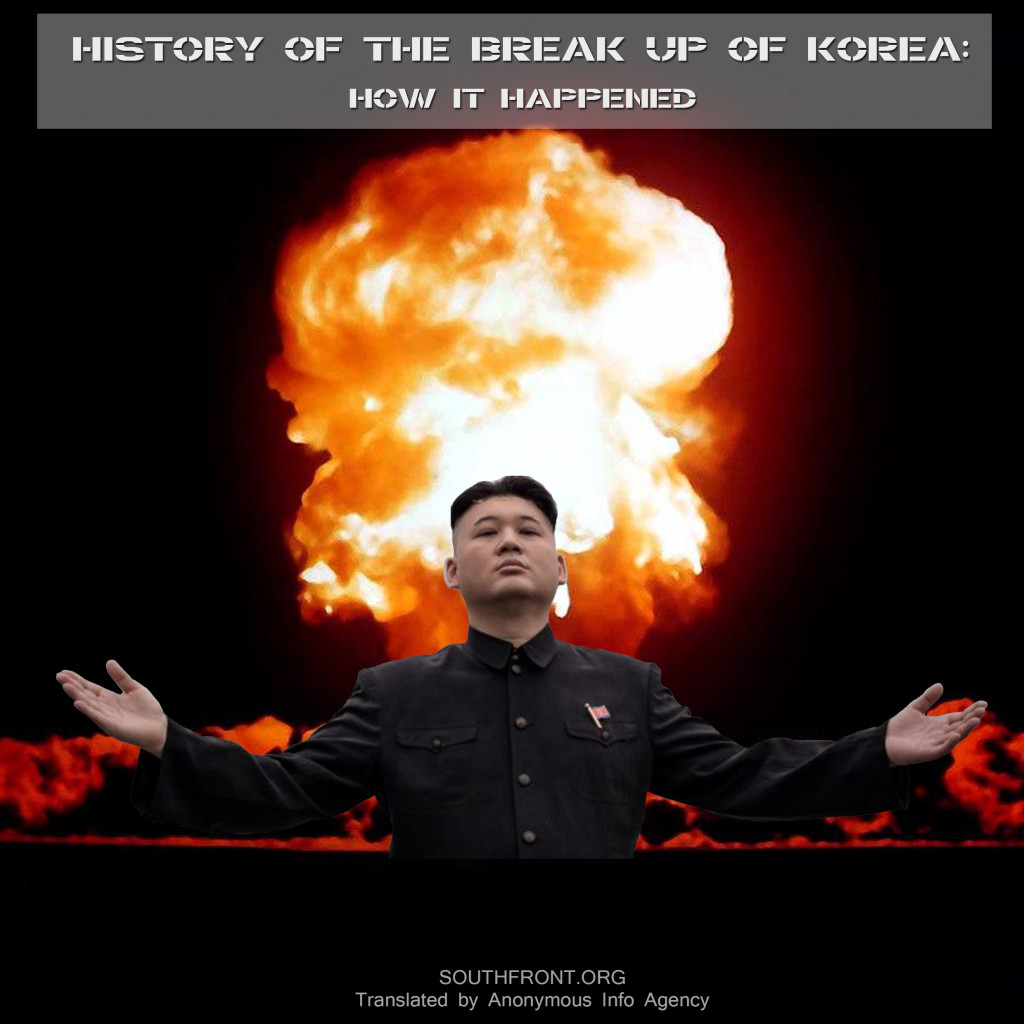As you know, South and North Korea once again entered a phase of an exacerbation of the conflict. Despite the agreement reached yesterday, the two sides remain in suspense, the balance is very fragile. What would happen – it would be clearer on Monday and now, let us remember the history of the splitting of Korea.

This article originally appeared at Politrussia, translated from Russian by Anonymous Info Agency exclusively for SouthFront
In the period from 1910 to 1945 Korea was under Japanese protectorate, with the very inhuman regime – Koreans faced the destruction of Korean culture, the prohibition of the use of language and so on.
For example: in 1939, the Governor-General Minami Jiro Korea issued a Decree about changing name under which the Koreans were allowed to take Japanese names, refusal was sentenced to such an extent that after six months 80.5% of Korean families have changed their names.
In August 1945, Korea was liberated by two sides: in the north by the USSR and the United States – in the south. After the Japanese surrendered in the north was formed the communist government led by Kim Il Sung, and in the south – capitalist led by Syngman Rhee. Initially it was assumed that South and North Korea will join, and this assumption is still valid now, although the deadline is moved further into the future, and the way to peaceful reunification less accountable.
The United States and the Soviet Union withdrew its troops from Korea, but have not agreed on terms of reunification, and then both Korean leaders wanted the reunification of Korea, but only under his personal leadership.
Gradually, the situation grew tense, and in the end, Kim Il Sung had persuaded Stalin that they should try to unite Korea by force, considering that the population supports the overthrow of the South Korean government.
The start of war was excellent: three days later Seoul was captured, the capital of South Korea, but there was no support of the local population, on which the North Korean leadership was counting. Syngman Rhee with the majority of its government evacuated, and although about 90% of the territory of South Korea was occupied by the army of the DPRK, the last checkpoint was defended hard – and to the rescue were already coming US and UN troops. On the side of South Korea, in addition to the United States, United Kingdom, Philippines, Canada, Turkey, the Netherlands, Australia, New Zealand, Thailand, Ethiopia, Greece, France, Colombia, Belgium, South Africa and even Luxembourg sent its military. This group of troops had about half a thousand tanks, about fifteen thousand guns and mortars, and more than a thousand aircraft, ground forces were supported from the sea with 230 ships of the US and its allies. Against this armada, North Korea did not have a chance, although it was unofficially supported by China, allowing hundreds of thousands of volunteers to support the neighbor. Alas, said the lack of heavy weapons, and the Soviet Union had no reason to intervent in the conflict, and only sent a small number of advisors.
In the summer of 1951, the fighting reached an impasse and the negotiations lasted more than two years in parallel with the continuation of the war actions. In 1953 a formal peace was signed, but the relationship did not improved. It is significant that in April 1954 in Geneva a peace conference was convened, which ended without result. Besides that, the offers of the North and South is fundamentally different, but South Korea, acting under the supervision of the United States, refused to fix the preliminary agreement, even in situations where the point of view coincided with the North Korea, clearly demonstrating the unwillingness to solve the problem.
Later, in January, 1958, the United States in South Korea deployed nuclear weapons which is completely contrary to the peace treaty – also a very significant thing. Incidentally, although the war in the Asian region have always been cruel, it is South Korea who extrajudicially executed tens of thousands of fellow countryman on suspicion of “communist views”, which North Korea never did for “capitalistic views”.
After Stalin’s death, North Korea has lost the support of the Soviet Union, which made the situation in the country even more difficult. However, the people survived, and at first the DPRK in terms of their development and well-being were even ahead of South Korea. However, the US needed a “showcase of capitalism,” and South Korea moved part of the production from Japan, as well as providing significant financial assistance – as a result of “showcase” South Korea looks beautiful compared with North Korea, which exists almost as an autarky.
After the collapse of the Soviet Union, North Korea may have to be quite bad and Seoul could count on a rematch, but just at the beginning of the 90s, North Korea has developed its own nuclear weapons, which gave security guarantees from the US military aggression, including – and through the territory of South Korea.
The entire post-war history of Korea – is a illustration of US foreign policy, which seeks to “divide and conquer” (except where beneficial to combine and conquer, as in the EU). The conflict in North and South Korea – a great reason to keep US troops in the region and have air defenses next to China, the rising of which has increasingly concerned the United States. So it invented such stories about the DPRK, that even the Ukrainians jealous about Russia are not that creative.
Clearly, in such circumstances, periodically erupting conflicts, and theoretically any of them could escalate into war – especially if the US decides to exclude itself from Ukraine: the need for some armed conflict remains, on which they can writte off debt and that can distract their citizens from domestic problems. So let’s see how events will unfold in the week.





